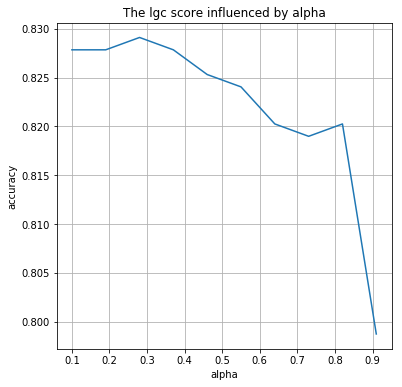下面通过 Python 写了一个可以通过修改 sigma 参数的 lgc (Learning with Local and Global Consistency1)模型。参考 Wittawat Jitkrittum 解读。
下面是具体的代码细节:
%matplotlib inline
import numpy as np
from sklearn.metrics import pairwise_distances
def calculate_W(X, sigma, Y=None):
dm = pairwise_distances(X, Y, metric='euclidean')
W = rbf(dm, sigma)
np.fill_diagonal(W, 0) # 对角线全为 0
return W
def one_hot(labels):
'''
对标签做 one_hot 编码
参数
=====
n_classes:
'''
label_dict = dict(enumerate(np.unique(labels)))
n_classes = len(label_dict) # 类别数
index_dict = {v: k for k, v in label_dict.items()}
Y = np.asanyarray([index_dict[label] for label in labels])
out = Y[:, None] == np.arange(n_classes)
return out.astype(float), label_dict
def rbf(x, sigma):
return np.exp((-x) / (2 * sigma**2))
class LGC:
def __init__(self, x_l, x_u, y_l, sigma, epochs):
self._epochs = epochs
self._X = np.concatenate([x_l, x_u])
Y_l, self.label_dict = one_hot(y_l)
self.labels = y_l
self.n_classes = len(self.label_dict)
Y_u = np.zeros((x_u.shape[0], self.n_classes))
self._sigma = sigma
self._input = np.concatenate([Y_l, Y_u])
@property
def sigma(self):
return self._sigma
@sigma.setter
def sigma(self, value):
return value
@property
def W(self):
dm = pairwise_distances(self._X, metric='cosine') # 余弦距离
W = rbf(dm, self.sigma)
np.fill_diagonal(W, 0) # 对角线全为 0
return W
@property
def D(self):
# calculate D
diago = np.sum(self.W, axis=1)
return np.diag(diago)
@property
def S(self):
d = np.sum(self.W, axis=1)
# S 是 np.sqrt(np.dot(diag(D),diag(D)^T))
S = np.sqrt(d * d[:, np.newaxis])
return np.divide(self.W, S, where=S != 0)
def fit(self, alpha):
self.F = self._input
for t in range(self._epochs):
self.F = np.dot(self.S, self.F) * alpha + (1 - alpha) * self._input
def score(self, y_u):
return (self.F.argmax(1)[len(self.labels):] == y_u).mean()
def test_lgc(lgc_params):
from matplotlib import pyplot as plt
lc = np.arange(.1, 1, 0.09)
lscore = []
for c in lc:
model = LGC(*lgc_params)
model.fit(c)
lscore.append(model.score(y_u))
print("The best c: %f" % lc[np.argmax(np.array(lscore))])
print("The best score: %f" % np.max(np.array(lscore)))
plt.figure(figsize=(6, 6))
plt.plot(lc, lscore)
plt.title('The lgc score influenced by alpha')
plt.xlabel('alpha')
plt.ylabel('accuracy')
plt.grid()
plt.show()
if __name__ == "__main__":
from sklearn.datasets import make_moons
n = 800 # 样本数
n_labeled = 10 # 有标签样本数
X, Y = make_moons(n, shuffle=True, noise=0.1, random_state=1000)
x_l, x_u = X[:n_labeled], X[n_labeled:]
y_l, y_u = Y[:n_labeled], Y[n_labeled:]
epochs = 200
sigma = .2
lgc_params = x_l, x_u, y_l, sigma, epochs
test_lgc(lgc_params)
The best c: 0.280000
The best score: 0.829114
详细内容见:动手实践标签传播算法
Zhou D, Bousquet O, Lal T N, et al. Learning with Local and Global Consistency[C]. neural information processing systems, 2003: 321-328. ↩︎
点击查看更多内容
为 TA 点赞
评论
共同学习,写下你的评论
评论加载中...
作者其他优质文章
正在加载中
感谢您的支持,我会继续努力的~
扫码打赏,你说多少就多少
赞赏金额会直接到老师账户
支付方式
打开微信扫一扫,即可进行扫码打赏哦





